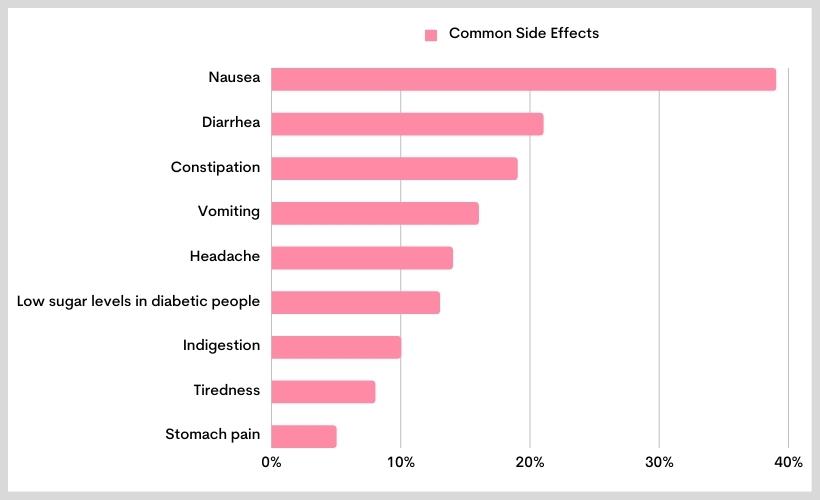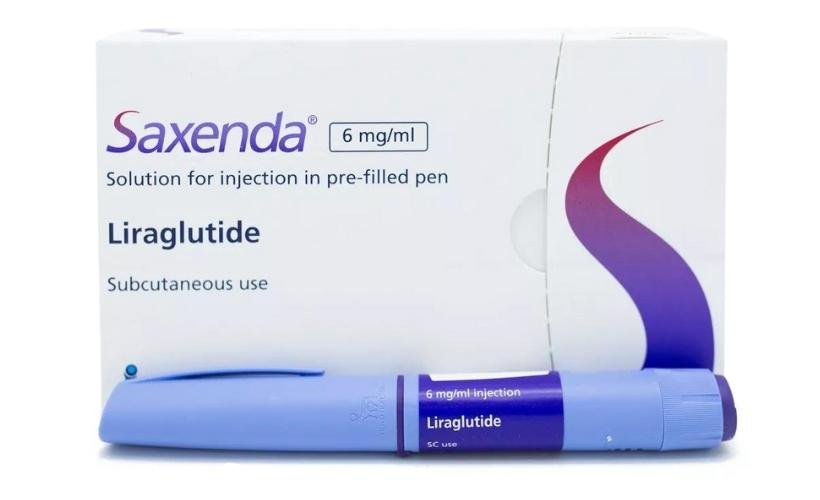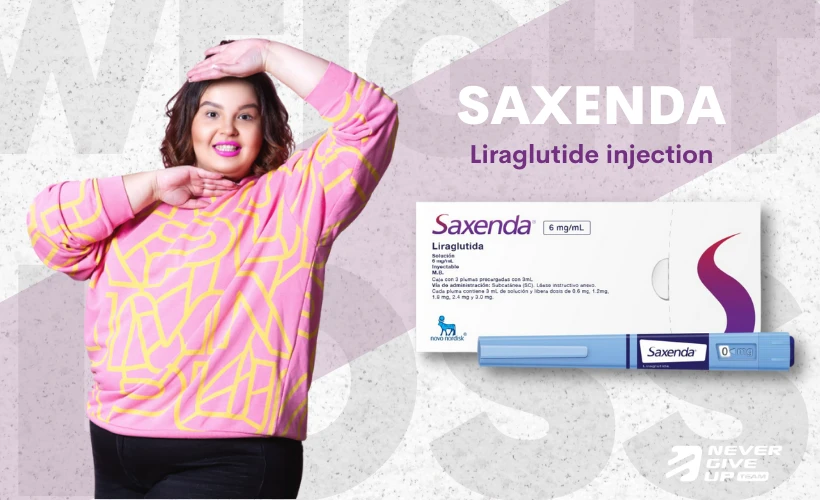BRAND INFORMATION
Brand name: Saxenda [‘sʌkse:ndə]
Active ingredient: Liraglutide
Schedule: S4
Class: GLP-1 agonist
Manufacturer: Novo Nordisk Pharmaceuticals Pty
Consumer medicine information (CMI) leaflet
Please read this leaflet carefully before you start using Saxenda.
Do not share your Saxenda® pen with others even if the needle has been changed. You may give other people a serious infection or get a serious infection from them.
Contents
What Saxenda® is and what it is used for
Saxenda® is a weight loss medicine that contains the active ingredient liraglutide.
Saxenda® includes liraglutide. It’s comparable to the intestine-released hormone GLP-1. Saxenda® is injected once a day.
Saxenda® is used in persons 18 and older who have:
✓ a BMI above 30 (obese);
✓ BMI between 27 and 30 (overweight);
✓ weight-related health concerns (diabetes, high blood pressure, abnormal blood lipids, sleep apnea).
After 12 weeks on 3.0 mg/day of Saxenda, you should have dropped at least 5% of your starting body weight. For long-term treatment, it’s needed to consult a doctor. Saxenda® should be taken alongside a low-calorie diet and exercise.
BMI Calculator
?
BMI is calculated by dividing your weight in kilograms by your height in metres squared.
Enter your measurements and click ‘calculate’ for your body mass index.
If your BMI is above or below the normal range but you consider yourself to be of normal and healthy weight for your height, chat with your doctor about any potential health concerns.
This calculator has been reviewed by NeverGiveUpTeam experts and is based on reputable sources of medical research. It is not a diagnostic tool and should not be relied on as a substitute for professional medical or other professional health advice.
BMI measures weight in proportion to height. It’s calculated by dividing weight by height squared.
Saxenda® acts on brain receptors that affect hunger, making you feel fuller. This way, you may eat less and lose weight.
Also, Saxenda® helps you maintain your new weight and avoid weight gain.
Before you start to use it
✕ Children and teens under 18 should not take Saxenda®. Because the drug’s effects on this age range are unknown.
✓ Saxenda® is not addictive.
✓ Saxenda® is available only with a doctor’s prescription.
During Saxenda® therapy, tell your doctor if you have:
✓ diabetes (Saxenda® shouldn’t replace insulin; Saxenda® and insulin are incompatible);
✓ cardiac failure (If you have severe heart failure, don’t use Saxenda®);
✓ prescription for any weight loss meds, OTC, or natural weight-loss drugs;
✓ Crohn’s disease;
✓ gastroparesis;
✓ thyroid disease, including nodules and enlargement.
✓ renal disease/dialysis;
✓ liver issues;
✓ pancreatitis;
✓ depression, suicidal thoughts, or another mental disorder;
✓ gained weight due to medical issues or medications.
Drink lots of water to prevent dehydration before starting Saxenda®. Dehydration causes renal issues requiring dialysis. If you have questions, see your doctor.
Stop taking Saxenda® and visit a physician if you have severe upper abdominal discomfort, especially on the right side. Back or right shoulder discomfort may occur. When you lose weight, you can get gallstones and gallbladder inflammation.
Saxenda® isn’t well-studied in patients around 75 y.o. Over 75s should avoid it.
Tell your doctor if you’re allergic to other drugs, foods, preservatives, or dyes.
If pregnant or planning pregnancy
In case of pregnancy or planning pregnancy, inform your attending physician. The drug’s effect hasn’t been researched during pregnancy. Pregnancy is a contraindication for Saxenda®. Saxenda® may damage a fetus.
Breastfeeding
Breastfeeding or planning to breastfeed? Tell your doctor. Saxenda® breast milk pass-through is unknown. Breastfeeding women shouldn’t take Saxenda®.
Before using Saxenda, notify your doctor about anything mentioned above.
Precautions
Before using liraglutide, tell your doctor or pharmacist if you are allergic to it; or if you have any other allergies. This product may contain inactive ingredients, which can cause allergic reactions or other problems. Talk to your pharmacist for more details.
Before having surgery, tell your doctor or dentist about all the products you use (including prescription drugs, nonprescription drugs, and herbal products).
Before surgery, tell your doctor or dentist about all the products you use (including prescription, nonprescription, and herbal products).
If you have diabetes, this product may affect your blood sugar. Check your blood sugar regularly as directed and share the results with your doctor. Tell your doctor right away if you have symptoms of low blood sugar (see Side Effects section). Your doctor may need to adjust your diabetes medication(s), exercise program, or diet.
This medication must not be used during pregnancy. It may harm an unborn baby. If you become pregnant or think you may be pregnant, tell your doctor right away.
It is unknown if this medication passes into breast milk. Consult your doctor before breast-feeding.
Consult your pharmacist or physician.
Interactions
Drug interactions may change how your medications work or increase your risk for serious side effects. This document does not contain all possible drug interactions. Keep a list of all your products (including prescription/nonprescription drugs and herbal products) and share it with your doctor and pharmacist. Do not start, stop, or change the dosage of any medicines without your doctor’s approval.
Some products that may interact with this drug include diabetes medications (such as insulin, sulfonylureas including glyburide).
Do not use this drug with any other product that contains liraglutide or other medications which are similar to this medication but used for diabetes (such as exenatide, dulaglutide).
Taking other medicines
Tell your doctor or pharmacist if you are taking any other medicines, including any that you buy without a prescription from your pharmacy, supermarket, naturopath or health food shop.
In particular, tell your doctor or pharmacist if you are using medicines:
✓ for the treatment of type 2 diabetes, such as a sulfonylurea (including glimepiride or glibenclamide). You may get low blood sugar (hypoglycaemia) when you use these medicines with Saxenda®. Your doctor may adjust the dose of your diabetes medicine to prevent you from getting low blood sugar.
✓ to thin your blood (anticoagulants), such as warfarin or other types of medicines called ‘coumarin derivatives’. Your doctor may need to monitor you more closely.
✓ for high blood pressure, such as amlodipine, atenolol or bisoprolol or for heart disease, such as digoxin.
✓ for HIV, such as atazanavir or ritonavir.
Tell your doctor about any other medicines that you are taking. This is very important. Your doctor will advise you if it is alright to keep taking them or if you should stop taking them.
Do not use Saxenda® if
- you or any of your family have ever had Medullary thyroid cancer (MTC) or if you have Multiple endocrine neoplasia type 2 (MEN 2).
- you are allergic to liraglutide or any of the ingredients in Saxenda®.
- you are pregnant or plan to become pregnant. Saxenda® may harm your unborn baby
How to use Saxenda®
Your doctor or pharmacist will have given you advice on how to use your medicine. Carefully follow all the directions. They may differ from the information contained in this leaflet.
If you do not understand the instructions, ask your doctor, nurse or pharmacist for help.
Your doctor will start you on a diet and exercise programme. Stay on this programme while you are using Saxenda®.
Saxenda® is supplied as a pre-filled pen containing liraglutide. The Saxenda® pen can give doses of 0.6 mg, 1.2 mg, 1.8 mg, 2.4 mg or 3.0 mg.
How much to use
Your doctor will tell you how much of this medicine you need to use each day.
✓ The usual starting dose is 0.6 mg once a day.
✓ Your doctor will tell you how long to keep taking this dose. It will be for at least one week.
✓ Your dose may then be increased by 0.6 mg each week until you reach the recommended dose of 3.0 mg once a day.
✓ Your doctor will tell you how much Saxenda® to use each week. Usually, you will be told to follow the table below:
| Week | Dose to inject |
|---|---|
| 1 | 0,6 mg once a day |
| 2 | 1,2 mg once a day |
| 3 | 1,8 mg once a day |
| 4 | 2,4 mg once a day |
| 5 onwards | 3,0 mg once a day |
Once you reach the recommended dose of 3.0 mg in week 5 of treatment, keep using this dose until your treatment period ends. Do not increase your dose further.
Visit your doctor regularly to assess your need for continued treatment with Saxenda®.
Do not change your dose unless your doctor has told you to.
When to use it
You can use Saxenda® at any time of day, with or without food and drinks. It is preferable to use Saxenda® at about the same time each day, at a time that is most convenient for you.
If you use more Saxenda® than you should, talk to your doctor or go to a hospital immediately. Take the medicine pack with you. You may need medical treatment. Using too much Saxenda® may cause nausea (feeling sick), vomiting (being sick), or low blood sugar (hypoglycaemia). see below for the early warning signs of hypos.
While you are using Saxenda®
Must-dos
Tell your doctor if you have diabetes. Your physician may change your diabetic medication to avoid ‘hypos’ (low blood sugar levels).
- Don't inject Saxenda with other drugs (e.g. insulins).
- Do not combine Saxenda® with GLP-1 receptor agonists (e.g. exenatide or lixisenatide).
Travelling? Tell your doctor, nurse, or pharmacist. Request a letter outlining why you’re bringing injectables. You should carry several copies of this letter to each state you visit.
Your destination country may not have Saxenda®. A doctor, nurse, or pharmacist can give you helpful tips.
Things you must not do
- Do not stop taking your medication until instructed.
- Do not use this medicine if you think it has been frozen or exposed to excessive heat.
- Use this drug just as your doctor directs.
- Even if others have the same ailment, don't share your medication.
- Do not share needles or pens.
Things to be careful of
Drive carefully until you know how Saxenda® affects you. Consult your doctor or pharmacist for details.
If you forget to use it
If you forget a dose and remember it within 12 hours from when you usually take the dose, inject Saxenda® as soon as you remember.
However, if more than 12 hours have passed since you should have used Saxenda®, skip the missed dose and inject your next dose the following day at the usual time.
Do not use an extra dose or increase the dose on the following day to make up for the missed dose.
If you are unsure what to do, talk to your doctor, nurse or pharmacist.
Side effects
Immediately tell your doctor, nurse, or pharmacist if Saxenda® makes you sick. Every drug has adverse effects. They’re sometimes serious, but usually not. However, side effects may need medical attention.
Don’t be concerned by these adverse effects. None of these may happen. Ask your doctor, nurse, or pharmacist if you need to clarify anything.
Saxenda® often causes:
- nausea
- vomiting;
- diarrhoea;
- constipation;
- headache.
These are mild side effects that lessen with regular drug usage.
If any of the following concerns you, see your doctor:
- changed sense of taste;
- dizziness;
- indigestion (dyspepsia);
- bloating, burping, gas, dry mouth;
- heartburn;
- abdominal pain/swelling;
- hypoglycemia;
- injection site reactions (bruising, pain, irritation, itching and rash);
- tachycardia;
- fatigue;
- sleeplessness (insomnia).
These symptoms might occur in the first 3 months of therapy.
This list contains typical pharmaceutical side effects – mild and temporary.
Less common side effects:
- feeling bad overall;
- hives (a type of skin rash);
- loss of fluids (dehydration);
- nervousness.
This may be caused by vomiting, nausea, and diarrhoea at the beginning of therapy.
Hypos are more common in diabetics receiving sulfonylurea. Hypo may strike abruptly. Hyposymptoms include:
- pale skin, chilly sweat;
- headache;
- tachycardia;
- nausea;
- feeling famished;
- vision changes;
- sleepiness;
- feeling weak, frightened, or confused;
- difficulties with concentration;
- rattle (tremor).
Your doctor can tell you how to manage low blood sugar and what to do if you have these symptoms. If you’re taking sulfonylurea when you start Saxenda®, your doctor may cut the dosage.
Tell your doctor immediately if you:
- have strong abdominal pain that may reach your back, nausea, and vomiting. This might be pancreatitis - serious, life-threatening condition. If this happens, stop taking Saxenda®.
- get a lump or swelling in your neck, hoarseness, trouble swallowing, or shortness of breath.
- experience the signs of reduced kidney function, which may include reduction in urine volume, a metallic taste in your mouth and bruising easily.
- feel upper right side abdominal pain, yellowing of the skin and eyes or clay-coloured stools, which may be signs of gallbladder problems.
- experience depression or mental changes that are new, severe, or worrying.
Tell your doctor if you notice anything else that is making you feel unwell.
Inform your doctor immediately or go to Accident and Emergency at your nearest hospital if you notice any of the following:
- skin rashes over a large part of the body;
- shortness of breath, wheezing;
- swelling of the face, lips or tongue;
- fast heartbeat;
- sweating.
This list includes serious side effects that could be signs of a severe allergic reaction. You may need urgent medical attention or hospitalisation. These side effects are rare.
Other adverse effects not listed above may also occur in some people.
Ask your doctor, nurse or pharmacist to answer any questions you have.
To better understand the common side effects of Saxenda, check out a poll’s results below:

Product description
What it looks like
Saxenda® is supplied as a clear and colourless solution for injection in a pre-filled pen. Each pen contains 3 mL of solution, and is able to deliver doses of 0.6 mg, 1.2 mg, 1.8 mg, 2.4 mg or 3.0 mg.
Saxenda® is available in packs containing 1, 3 or 5 pens. Not all pack sizes may be marketed.
This medicine is a colorless, clear, injection
Needles are not included.

Supplier/Sponsor
| Location | Australia | New Zealand |
|---|---|---|
| Company | Novo Nordisk Pharmaceu ticals Pty. Ltd. | Novo Nordisk Pharmaceuticals Ltd. |
| Address | Level 10
118 Mount Street North Sydney NSW 2160 | 58 Richard Pearse Drive Airport Oaks Mangere |
Saxenda®, NovoFine® and NovoCare® are trademarks owned by Novo Nordisk A/S.© 2021
Novo Nordisk A/S
Further information
The Australian ‘Product Information’ document is available from the following websites:
www.novonordisk.com.au
https://www.ebs.tga.gov.au/
For further information call the NovoCare® Customer Care Centre on 1800 668 626 or 0800 733 737 (NZ).
www.novonordisk.com.au
www.novonordisk.co.nz
further dietary advice, refer to the dietary guidelines on the NH&MRC website at www.nhmrc.gov.au (Australia), or the current food and nutrition guidelines on the Ministry of Health website at www.health.govt.nz (New Zealand).
References
- Saxenda. Available from: [URL Link]
- Saxenda Subcutaneous: uses, side effects, and more. Available from: [URL Link]
- Saxenda – NPS Medicinewise. Available from: [URL Link]
- Saxenda (liraglutide) injection 3 mg savings card, Novocare. Available from: [URL Link]
- Using the Saxenda® Pen. Available from: [URL Link]
- Saxenda (liraglutide) injection 3 mg. Official physician site. Available from: [URL Link]
- Saxenda: uses, dosage, and side effects. Available from: [URL Link]
- Saxenda 6 mg/mL solution for injection in pre-filled pen. Available from: [URL Link]
- Saxenda (liraglutide): basics, side effects &reviews. Available from: [URL Link]
- Saxenda. European Medicines Agency. Available from: [URL Link]
- Saxenda. Healthdirect. Available from: [URL Link]
NeverGiveUpTeam is not for emergency usage. Call triple zero (000) if you have an acute sickness, overdose, or emergency.
When created, correct information was provided. This material shouldn’t be used to replace medical advice, diagnosis, or treatment. Please see our terms and conditions.
FAQ
Weight loss normally starts within 2 weeks of starting Saxenda (liraglutide).
Upon stopping Saxenda (liraglutide), people are likely to regain the weight lost. This is why it’s important to work with your provider to learn how to use diet and exercise to maintain your weight.
It is not a type of insulin, but it can impact the amount of insulin your body releases. This medication is also available as Victoza (liraglutide) for diabetes.
You may inject it at the most convenient time for you (such as before breakfast, lunch, dinner, or bedtime), but it should be injected at approximately the same time each day.
The majority of the side effects may go away during treatment as your body adjusts to the medication.



I stopped taking Saxenda and decided to do it on my own. I never regretted it.
The precaution about driving while on saxenda is pure gold. I wish I had known that a few months ago.
It looks like I knew even things I shouldn’t know)), so many side effects…
Found what I looked for. Thanks!
I started to lose weight only after a month or so. Don’t wait for quick results, guys.
I don’t know anyone who reached the 3mg dose. It sounds really too much.
Once I had an allergic reaction to this drug. Very unpleasant, but the most important thing is to get what’s going on at once.
To everyone starting it: make sure you know how to inject properly. I didn’t, and it caused many troubles.
Great drug! I dropped 20 kg because of it!